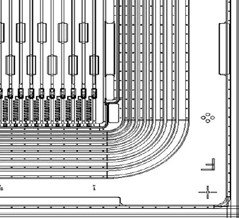Strip and PAD Detectors
Silicon strip detectors were the first devices using the lithographic capabilities of microelectronics to produce a detector with high position resolution. A strip detector is an arrangement of strip like shaped implants acting as charge collecting electrodes. Placed on a low doped fully depleted silicon wafer these implants form a one-dimensional array of diodes.
By connecting each of the metalized strips to a charge sensitive amplifier a position sensitive detector is built. Two dimensional position measurements can be achieved by applying an additional strip like doping on the wafer backside by use of a double sided technology.
Strip detectors have usually almost ‘wafer sized’ formats. Due to their simple structure single sided devices can be produced cost-effective at automated production lines on 150 and 200 mm wafers.

The major projects during the nineties were the development of detectors being able to withstand harsh radiation environments at the Large Hadron Collider (LHC) at CERN in Geneva. At LHC protons are brought to collision with a center of mass energy of 14 TeV. At this high energies new particles might be produced which will shed light on one of the remaining mysteries of particle physics: The origin of mass. The ATLAS detector is one of the two large detectors at LHC which detects such particles.
The work on strip detectors is a smooth continuation on previous work of our group which has seen the introduction of strip detectors into HEP, the first double sided strip detectors, a new method of biasing for capacitive coupled strip readout and guard ring structures for avoidance of electrical breakdown.
The MPG HLL was deeply involved in the ALTAS project namely the inner detector with its silicon tracker (SCT), based on silicon strip detectors and the vertex detector, based on hybrid pixel detectors.
The results of the detector development at MPG HLL had an essential impact on the detector decisions made for ATLAS SCT and ATLAS Pixel. Using detectors designed and fabricated in our laboratory demonstrated that the required properties can indeed be fulfilled. After this demonstration both ATLAS sub-detectors opted for the concepts we proposed.
The novel ATLAS pixel sensors use an n-in-n technology (n+-doped readout pads in n-doped substrate) and were fabricated with a new p-spray isolation technology developed and patented by MPG HLL.
